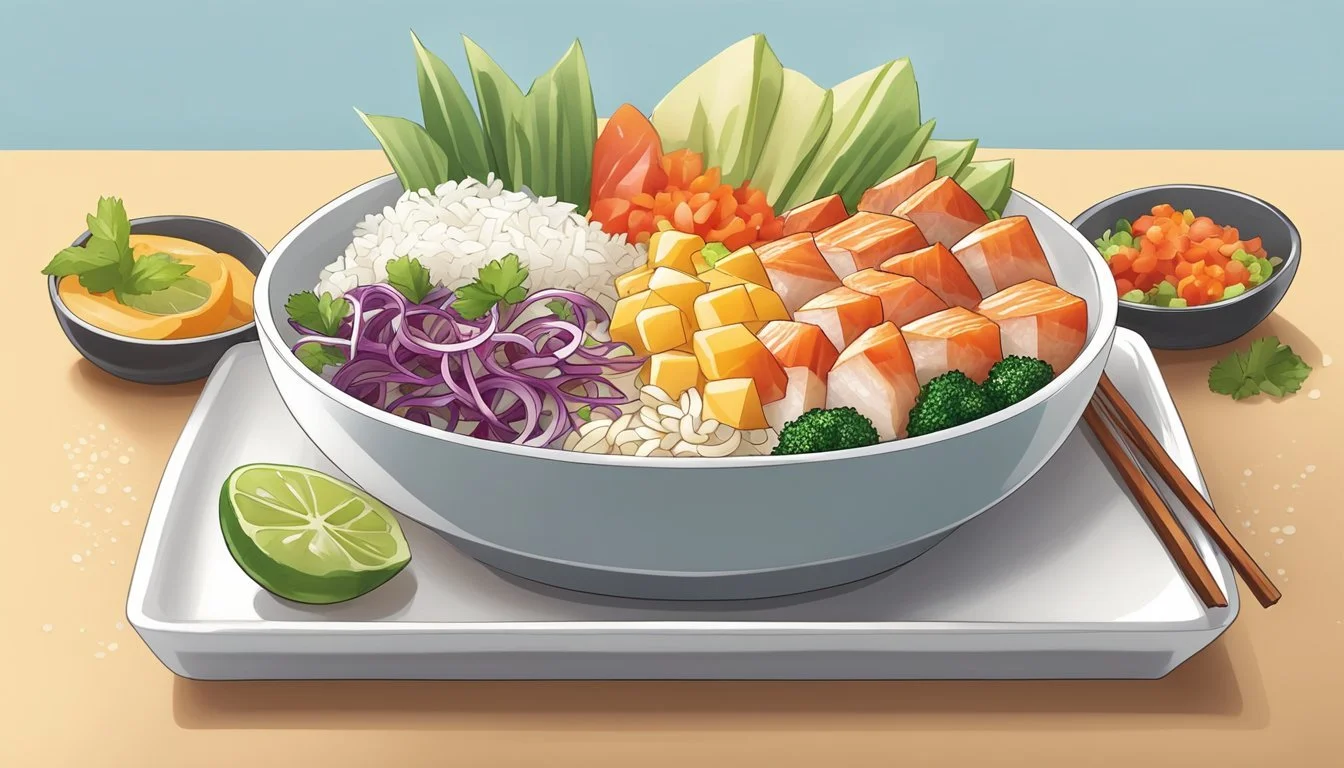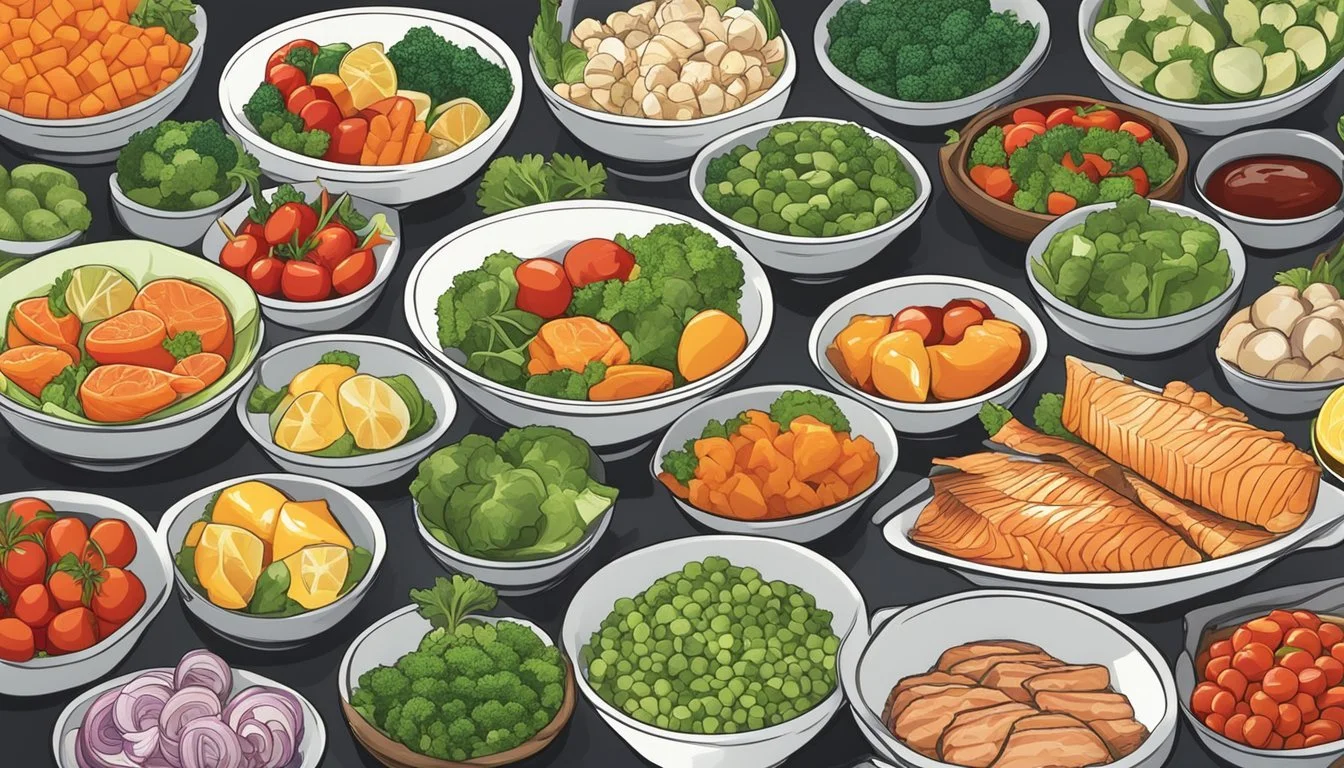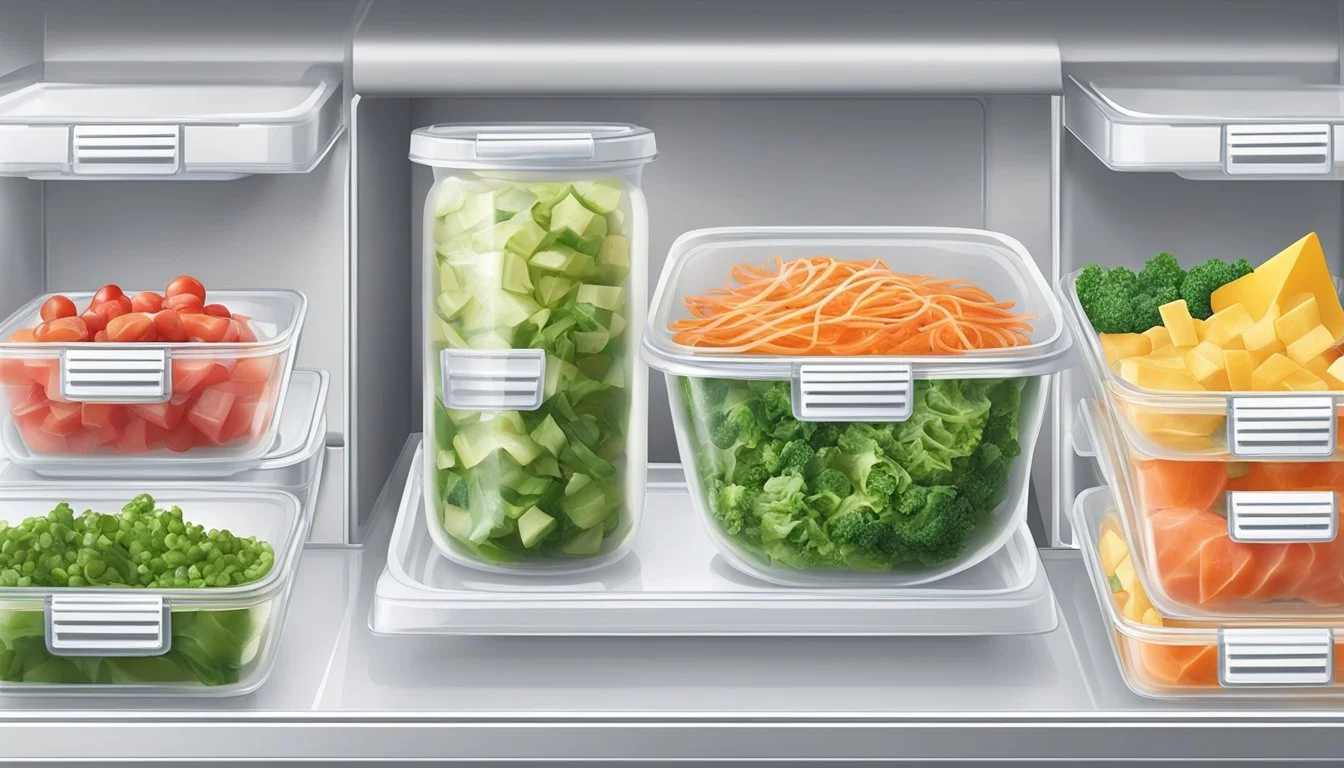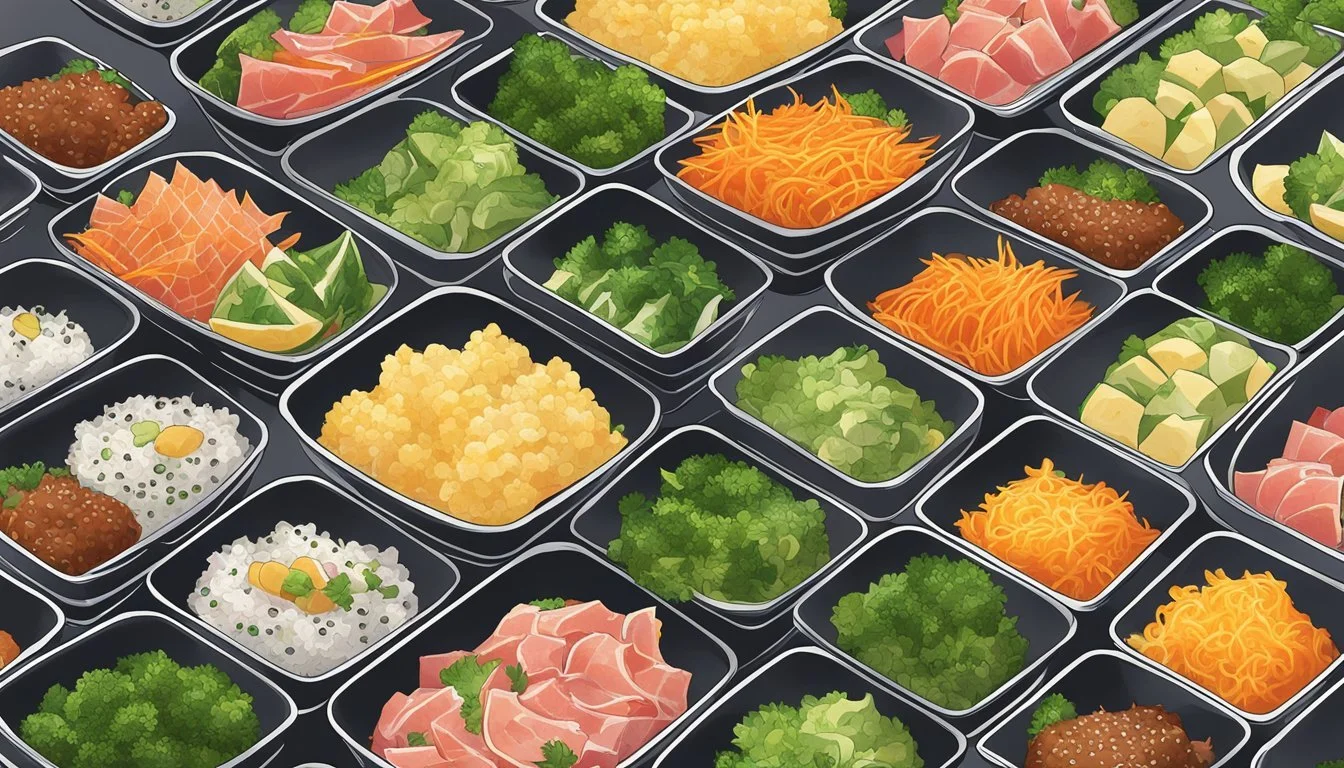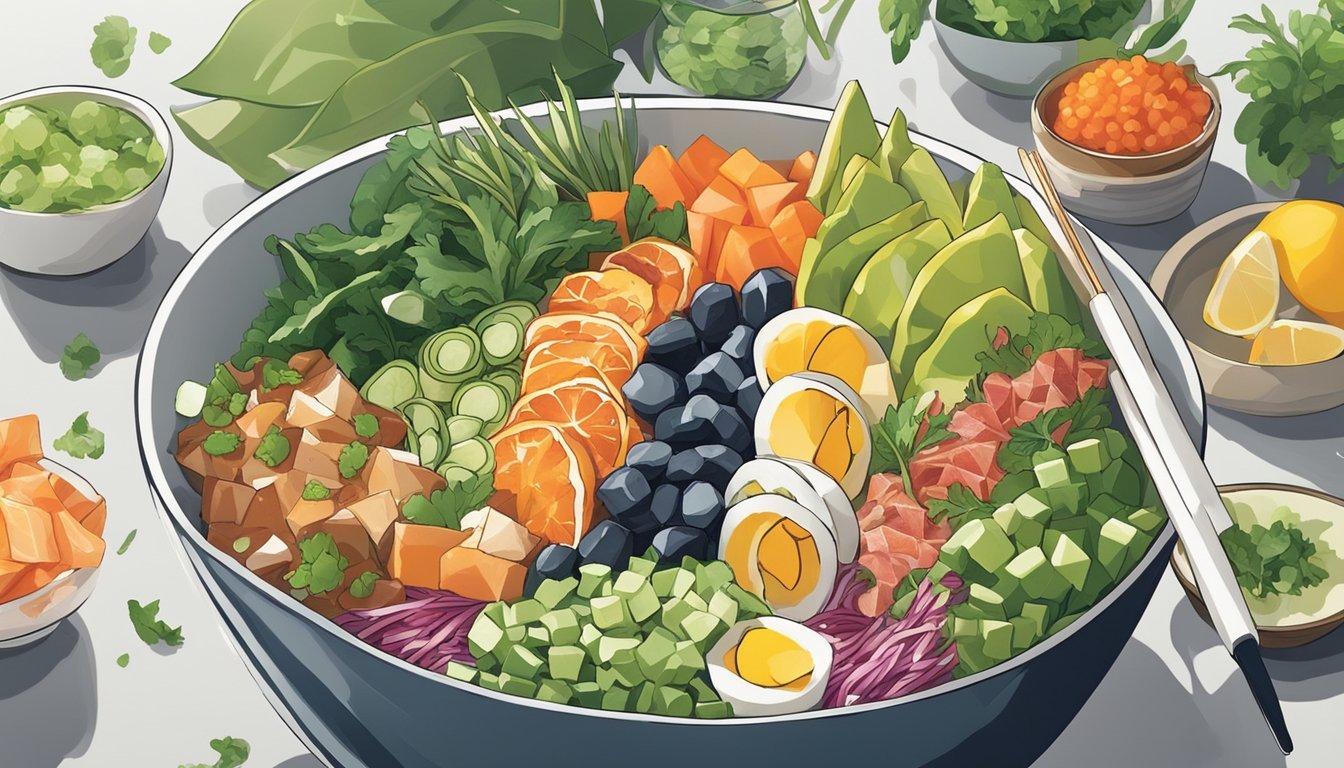How Long Do Freshly Prepared Poke Bowls Last?
Shelf Life and Storage Tips
Poke bowls are a delightful culinary tradition that originate from Hawaii, offering a wholesome combination of diced raw fish, often tuna (What wine goes well with tuna?), with a variety of mix-ins and seasonings served atop a bed of rice or greens. A fresh poke bowl is not only a burst of rich flavor and varied textures but is also packed with nutrients. However, due to the use of raw fish, which is susceptible to bacterial growth, the shelf life of a poke bowl is a crucial factor for both safety and taste.
Refrigeration plays a vital role in extending the longevity of poke bowls. When stored in sealed containers and kept at a consistent, cold temperature, poke bowls can last for 1 to 2 days. Factors such as the freshness of the fish at the time of preparation and how long it was out at room temperature can affect how long it remains edible. It's always best to consume a poke bowl on the same day it's prepared to ensure the highest quality and flavor.
The ingredients accompanying the fish, like avocado and marinated vegetables, also influence the longevity of a poke bowl in the fridge. While these ingredients can remain safe to consume for 3 to 4 days, one may notice a decline in taste and appearance over time, especially with ingredients like avocado, which may brown. To maintain a poke bowl's sensory appeal and to enjoy its authentic taste profile, it is recommended to consume it promptly.
Understanding Poke Bowls
Poke bowls exemplify a blend of Hawaiian tradition and the flavors of Japanese cuisine, featuring fresh ingredients and various combinations tailored to personal preference.
Origin and Cultural Significance
Poke, pronounced "poh-keh," originated in Hawaii and holds a significant position in Hawaiian cuisine. Its roots can be traced back to when indigenous Hawaiians seasoned raw fish with sea salt, seaweed, and crushed kukui nuts. This tradition evolved as Japanese influence integrated elements like soy sauce and sesame oil. Today, poke bowls are not just a Hawaiian staple but have gained immense popularity worldwide as a customizable and healthy meal option.
Basic Components of a Poke Bowl
A typical poke bowl consists of the following key elements:
Base: Usually consists of rice, often sushi-grade white or brown rice. Alternatives may include quinoa, (What wine goes well with quinoa?) salad greens, or noodles.
Protein: The central ingredient is usually raw, marinated fish such as tuna or salmon. (What wine goes well with salmon?) Cooked seafood, tofu, or chicken are also used.
Toppings and Add-ins: Includes a wide variety such as diced fruits and vegetables like avocado, mango, or cucumber, and garnishes such as green onions, sesame seeds, and seaweed.
Sauce: Commonly used sauces range from soy sauce-based to spicy mayo and ponzu.
Each ingredient is selected for both its flavor and nutritional value, affirming poke bowls as a representative dish of Hawaiian cuisine with a Japanese twist. Poke bowls are celebrated for their balance of proteins, healthy fats, and carbohydrates.
Ingredients and Freshness
When preparing a poke bowl, the longevity and quality largely depend on the freshness of the ingredients and the proper handling of the fish. It's essential to select top-quality components and understand the freshness indicators for sushi-grade fish to ensure both safety and taste.
Selecting Quality Ingredients
To ensure an enjoyable poke experience, it begins with selection of high-quality ingredients. Vegetables should be fresh and crisp; look for bright colors and avoid any that have soft spots or blemishes. Avocado, a common topping, should yield slightly to pressure, indicating ripeness without being overripe. For condiments such as ginger and sesame seeds, freshness also matters as they impart key flavors.
Fish: Sushi-grade tuna or salmon is pivotal.
Vegetables: Freshness should be apparent through vibrant colors and firmness.
Toppings and Marinade: Quality garnishes like fresh cucumber, mango, and marinated seaweed salad enhance the bowl's flavors.
Raw Fish:
Tuna (ahi): Should have a bright, true red or pink color.
Salmon: Look for vivid orange or deep pink with no discoloration.
It's a good practice to keep any raw fish well chilled prior to prep to maintain its quality.
Freshness Indicators for Fish
The main component in a poke bowl, raw fish, must exhibit certain characteristics to be deemed fresh and edible. Sushi-grade fish, often a reference to tuna and salmon, is the term for fish that has been handled and stored properly to minimize the risk of foodborne illness such as scombroid poisoning.
Visual Cues:
Color: The fish should have a clear, bright color typical for the species (e.g., deep red for ahi tuna).
Texture: The flesh should be firm, not falling apart or mushy, and should not feel slimy to the touch.
Sense of Smell:
Fish should have a clean smell; any overpowering fishy odor can be an indicator of decay.
Treat these components with the highest care, and always store them properly to maintain their optimal freshness.
Safe Storage Practices
Proper storage is essential to maintaining the safety and quality of freshly prepared poke bowls. These best practices help prevent spoilage and extend the shelf life of the seafood.
Ideal Storage Conditions
The ideal conditions for storing a poke bowl involve keeping it at a consistent temperature in the refrigerator. Seafood, specifically, must be stored at a temperature below 40°F to slow down bacterial growth.
Fridge: Always place poke in the fridge within two hours of preparation or purchase to maintain safety and freshness.
Airtight Container: Transfer poke to an airtight container to protect it from other flavors in the fridge and to reduce oxidation.
Aluminum foil or plastic wrap is not recommended for storing poke, as these do not provide a seal as effective as an airtight container for preventing the introduction of air that can cause spoilage.
Maximizing Shelf Life
To maximize the shelf life of poke, one must adhere to strict storage protocols immediately after preparation.
Refrigeration Timeframe: Consume poke within 1-2 days when kept in the fridge; beyond this point, the risk of developing slime or white slime, which indicates spoilage, increases.
Freezer: Freezing is not advisable for poke as it can compromise the texture and flavor of the seafood.
By wrapping leftovers securely and ensuring a consistent, cold temperature, the freshness of poke bowls can be preserved, allowing for safe consumption within the recommended time frame.
Health and Safety Considerations
When handling and storing poke bowls, it is vital for one to understand how to identify spoilage and recognize the potential health risks associated with consuming spoiled fish. Poke bowls, typically consisting of raw sushi-grade tuna or other proteins such as cooked shrimp, tofu, and sometimes vegan alternatives, are marinated in a blend of soy sauce, sesame oil, vinegar (often rice vinegar), and other ingredients. Ensuring the freshness and proper storage of these components is crucial for a healthy and enjoyable eating experience.
Recognizing Spoilage Signs
For the utmost safety, it is important to be vigilant in observing any signs of spoilage in poke bowls. Key indicators include:
Smell: Fresh fish should have a mild, not overly fishy scent. If the aroma is off-putting or strong, it may be spoiled.
Texture: Poke should be moist but not slimy. Any slime on fish is a telltale sign of spoilage.
Color: Look for any unusual changes. Sushi-grade tuna should have a vibrant color; any dullness can indicate it's past its prime.
Taste: If a small sample reveals an unexpected or sour taste, it's best to discard the poke.
Health Risks of Spoiled Fish
Consuming spoiled poke can pose serious health risks, as degraded fish products have the potential to cause foodborne illness. Important considerations include:
Bacteria Growth: Fish is highly perishable, and improper storage can result in rapid bacterial growth, like Salmonella or Listeria, which can lead to food poisoning.
Toxins: Some bacteria produce toxins that cooking cannot destroy, making it vital to eat fresh poke well within its safe time frame.
Allergens and Diet-Specific Risks: For vegetarians, vegans, or those with shellfish allergies, it is crucial to ensure cross-contamination is avoided both in the preparation and storage of vegan or vegetarian poke bowls.
Preparing a Poke Bowl at Home
Making a poke bowl at home combines the convenience of fresh ingredients with the flexibility of personalizing flavors. Essential elements like sesame oil and soy sauce form the foundation for a traditional, yet easily customizable dressing.
Step-by-Step Poke Bowl Recipe
Ingredients Required:
Fresh tuna or salmon
Short-grain sushi rice
Soy sauce
Sesame oil
Rice vinegar
Green onions
Optional toppings: mango, radishes, nuts, spicy mayo, masago, broccoli, etc.
Directions:
Rice Preparation: Begin by cooking short-grain sushi rice according to the package instructions. Let it cool to room temperature.
Fish Marinade: Cut the tuna or salmon into half-inch cubes. In a medium bowl, mix a generous amount of soy sauce with sesame oil and rice vinegar to taste. Toss in the cubed fish and let it marinate.
Chopping Toppings: Finely chop green onions, radishes, and any other desired vegetables like broccoli or salad greens. Dice mango for a sweet twist.
Assembling the Bowl: Place the cooled rice as the base. Top with the marinated fish and arrange the vegetables and other toppings such as avocado, edamame, or masago artfully on top.
Finishing Touches: Drizzle with extra sauce if desired and sprinkle with sesame seeds. Add dollops of spicy mayo made from sriracha and mayonnaise for creaminess and heat.
Creative Variations and Toppings
Quinoa for Rice: Quinoa can be used as a nutritious base alternative to rice. It's protein-rich and holds flavor well.
Adding Crunch: For texture, sprinkle chopped nuts or fried onions on top of the poke bowl.
Taste of the Sea: Octopus is another seafood option that adds a tender chewiness to the poke bowl.
Vegetable Diversity: Mix in salad greens like kale or spinach for added nutrients. Roasted broccoli florets can also provide a different flavor profile and a satisfying crunch.
Flavorful Sauce Options: Experiment with dressing variations by incorporating ingredients like mirin, ginger, or wasabi into the base soy sauce and sesame oil mixture.
Protein Varieties: Apart from the staple fish choices such as tuna and salmon, consider tofu or cooked chicken for a different protein source in your homemade poke bowl.
Remember, the key to a great poke bowl is using the freshest ingredients and enjoying the balance of textures and flavors.
Longevity and Consumption
The shelf life of a poke bowl is predominantly dictated by the freshness of the fish and the conditions under which the meal is stored. Ensuring optimal freshness upon consumption requires understanding the timelines and storage methods.
Recommendations for Consumption Timing
Consuming a poke bowl, typically consisting of raw fish such as tuna or salmon, is best when eaten immediately after preparation. Should one need to store it, 2 days in the refrigerator in sealed containers is the maximum recommended duration for maintaining its freshness and quality. By the third day, the quality of the poke, especially the fish component, often starts to diminish.
Day 1: Optimal freshness and flavor - consume immediately if possible.
Day 2: Consumable, but potential decline in texture and taste.
Day 3: Not recommended due to increased risk of spoilage.
Extending the Poke Bowl's Freshness
For those who must prolong the shelf life of a poke bowl, specific storage techniques are vital. Storing the fish in an airtight container or wrapping it tightly in aluminum foil before placing it in the fridge can help preserve its quality. In terms of prolonging freshness, keeping the ingredients separate — particularly the fish from the rice and vegetables — can also be beneficial.
Airtight Containers: Best for sealing out air and contaminants.
Aluminum Foil: Can provide an extra barrier around the fish.
Separate Storage: Keep fish, rice, and vegetable components in different containers.
It is worth noting that kitchen equipment and the initial quality of the cooking components play a crucial role in the overall life span of the poke bowl once stored.
Alternatives and Substitutes
For individuals with dietary restrictions or allergies, or those simply looking for a twist on the traditional poke bowl, there are various alternatives to the typical fish ingredients and rice base. These substitutes can offer new flavors and textures while remaining true to the essence of a poke bowl.
Non-Fish Poke Bowl Options
Tofu: Firm tofu can be cubed and marinated, serving as a hearty plant-based substitute for fish in a poke bowl.
Chickpeas: Seasoned chickpeas provide a protein-rich vegan alternative, adding a satisfying crunch.
Avocado: Avocado cubes can replace fish to create a rich, creamy poke that caters to vegetarians and vegans alike.
Jackfruit: Young, unripe jackfruit has a meaty texture and absorbs flavors well, making it suitable for vegan poke bowls.
Tips for Allergic and Dietary Restrictions
Grains: Instead of traditional white sushi rice, brown rice or quinoa can be used for those seeking whole grain alternatives.
Grains Notes Brown Rice A whole grain option rich in fiber. Quinoa A gluten-free and protein-packed seed.
Sauces/Seasonings: Always check labels for allergens and opt for gluten-free soy sauce or tamari if needed.
Soy Allergies: Consider coconut aminos as a flavorful soy-free option.
Vegetarian/Vegan Bowl Contents: Customizable poke bowls can include marinated mushrooms, edamame, or seaweed salad as protein alternatives.
Ingredients Dietary Consideration Marinated Mushrooms Umami-rich option for vegans and vegetarians. Edamame Provides additional plant-based protein. Seaweed Salad Brings a burst of ocean flavor without the fish.
By considering these alternatives and substitutes, poke bowls can be adapted to suit a wide range of tastes and dietary needs without compromising on the overall poke experience.
Conclusion
Poke bowls, a Hawaiian dish with Japanese influences, are known for their vibrant and fresh ingredients. The optimal shelf life of a poke bowl is contingent upon proper storage. When refrigerated in an airtight container, the dish typically maintains its quality for approximately 2-3 days. The fish, usually the central component of the dish, is especially perishable.
Temperature: Refrigeration should be kept at or below 40°F (4°C).
Containers: Use airtight containers to prolong freshness.
Visual Changes: Ingredients like avocado may brown, impacting presentation.
For individuals seeking longer storage solutions, freezing the fish is an option, extending the shelf life up to two months. However, the texture and taste of thawed fish can vary from its fresh counterpart.
Freezing: Fish can last 2-3 months when properly stored in a freezer bag or airtight container.
Consumers should be aware that while the dish may remain safe to consume after three days, both flavor and quality can diminish. They should perform a sensory evaluation before consumption, checking for any off smells or textures that may indicate spoilage.
Sensory Evaluation:
Smell: Check for any unusual or off odors.
Texture: Assess if the fish feels slimy or if vegetables have wilted.
Appearance: Look for discoloration or mold growth.
Careful consideration of these storage guidelines allows individuals to safely experience the enjoyment of poke bowls beyond their initial preparation.

